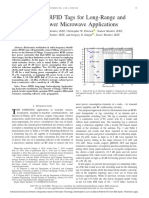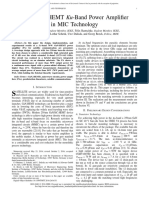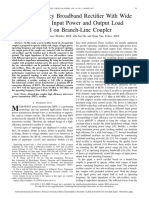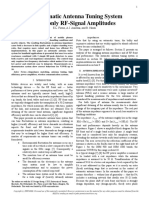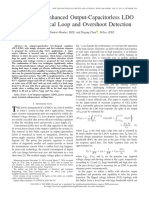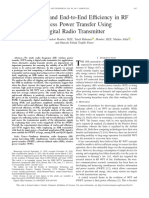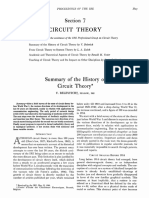A Wide-Band 20W LDMOS Doherty Power Amplifier
A Wide-Band 20W LDMOS Doherty Power Amplifier
Uploaded by
layil418Copyright:
Available Formats
A Wide-Band 20W LDMOS Doherty Power Amplifier
A Wide-Band 20W LDMOS Doherty Power Amplifier
Uploaded by
layil418Original Title
Copyright
Available Formats
Share this document
Did you find this document useful?
Is this content inappropriate?
Copyright:
Available Formats
A Wide-Band 20W LDMOS Doherty Power Amplifier
A Wide-Band 20W LDMOS Doherty Power Amplifier
Uploaded by
layil418Copyright:
Available Formats
See discussions, stats, and author profiles for this publication at: https://www.researchgate.
net/publication/241169897
A wide-band 20W LDMOS Doherty power amplifier
Article in IEEE MTT-S International Microwave Symposium digest. IEEE MTT-S International Microwave Symposium · May 2010
DOI: 10.1109/MWSYM.2010.5515172
CITATIONS READS
59 934
6 authors, including:
Igor Blednov
NXP Semiconductors
18 PUBLICATIONS 140 CITATIONS
SEE PROFILE
Some of the authors of this publication are also working on these related projects:
High Efficiency MOSFET RFIC for 5G View project
High power Doherty device arranged in a single RF package View project
All content following this page was uploaded by Igor Blednov on 20 May 2016.
The user has requested enhancement of the downloaded file.
A Wide-Band 20W LMOS Doherty Power Amplifier
J. H. Qureshi', N. Li', W.e. E. Neo2, F. van Rijs2, I. Blednov2 and L.e.N. de Vreede'
I
Dirnes, Delft University of Technology, Feldrnannweg 17, the Netherlands
2
NXP RF Power / Basestations, Gerstweg 2, Nijrnegen, the Netherlands
Abstract - This work discusses the efficiency bandwidth devices. Note that optimum wideband operation of the DPA
constrains in Doherty amplifiers. An analysis of the would require the transmission line TL to be a perfect
bandwidth limitations imposed by the impedance inverter impedance inverter over the whole desired frequency band.
and output capacitance of the active devices is given. Something that without changing the physical properties of
Alternative wideband matching and output connection the TL is not possible, since the electrical length of the TL
schemes for Doherty amplifiers are evaluated for their increases linearlY �i!p fre.flu.§n.fY..:.
_____
efficiency performance both at full output power, as well as , I
in power back-off operation. The presented theory is verified
Vout I
using a Doherty demonstrator amplifier, which allows
independent control of the input signals for the main and �I <E--
Port-2
peak device. The related measurements show the largest
high-efficiency bandwidth reported up to date for a Doherty
amplifier.
(Peaking
I. INTRODUCTION Device)
Currently the Doherty Power Amplifier (DPA) [1]
represents the most commonly used high efficiency concept
Fig. 1 Basic schematic of a Doherty Power Amplifier
in Base Stations. Its popularity results from its high
efficiency performance achieved at a low hardware Hence the TL forming the inverter will imposes
complexity and cost level. A well known disadvantage of bandwidth restrictions to the OPA concept. Note in view of
the DPA, however, is its narrow bandwidth (typically < this, also the phase relations versus frequency of the input
10%). This later property complicates its application in signals, which control the current sources should track
multiband / multi-standard communication systems. perfectly the phase delay provided by the TL impedance
Consequently, custom OPA solutions for each individual inverter at each frequency. In addition to this also the
need in the market have to be developed, raising costs and output capacitance of the PA devices proves to play a very
yielding logistic problems. To address this limitation, in this decisive role in defining the maximum bandwidth of the
work we invest how the OPA bandwidth for high efficiency DPA, something that we will also include later in our
operation can be expanded. The paper is organized as analysis.
follows. First we discuss the OPA bandwidth restrictions in
section II, in section III we evaluate various matching A. Bandwidth ofthe DPA with ideal devices
topologies and connection schemes that extends the OPA
To evaluate the frequency dependent efficiency behavior
bandwidth. The actual circuit realization is given in section
of the OPA we first assume that the PA devices can be
IV, followed by experimental verification in section V and
represented by ideal current sources with zero output
the conclusions in section VI.
capacitance. Moreover, the terminal voltages of the PA
devices (which are vital for efficiency) can be calculated
II. THEORY easily if the network enclosed by the dotted rectangle in the
Fig. 1 is represented by the impedance matrix [Z],
Doherty amplifier operation is a well established
technique to increase the average efficiency of microwave
power amplifiers [1][2][3]. The diagram of a two-way %
Zo(RLCOS(!,, )+ jZosin(J,, ) �
Doherty Power Amplifier (OPA) in its most elementary
Zo cost!"� %) + jRLsin(!" %) Zo cos(!,,!!...)+ jRLsin(!,,!!...)
form is given in the Fig. 1. Here the main and peak devices 2 2 (1)
are represented by current sources connected by a n:
transmission line (TL) impedance inverter, which has an ZoRL cos(J" 2)
electrical length of rrJ2 at the center frequency of the design.
Besides being vital for the operation of the DPA, the
impedance inverter is the only frequency dependent
Note that in (1) f. is the normalized frequency with respect
component in this elementary DPA schematic (Fig. I),
to the center frequency of the design (f.=f!f), Zo the
when implemented using ideal current source like PA
impedance of the TL impedance inverter and RL the load
978-1-4244-7732-6/101$26.00 ©2010 IEEE 1504 IMS 2010
impedance. The terminal voltages of the main (V,,) and the output capacitance of the active devices. Since practical PA
peaking amplifier (Vp) are simply given by (2) and (3), devices have both output and input capacitances, their
Vm=Z1/m+Z12 Ip (2) inherent bandwidth limitation (for a particular reflection
coefficient rm) due to input and output matching is given
Vp=Z2/m+Z2/P (3)
by the (Bode-Fano criteria [6]).
( J<�
with 1m and Ip representing the currents of the main and
peaking device respectively. Once the terminal voltages are 1
LlliJln _ (5)
known, the output power (Pout) and related effi ci en cy ( TJdpa) rm RC
of the total DPA as function of back-off power and However, this maximum bandwidth can only be only be
operating frequency, can be calculated as, achieved if the PA devices are matched using wideband
P 1C Re( V , . I;, )+ Re(Vou,.!p·)
o impedance matching techniques. This is traditionally done
TJdpa =�� (4) by matching the output of the PA as impedance. In such an
�c 4 i Vm(max) i I Im l+i Vp(max) iiIpi
approach first the reactive part is tuned out by a series
Note that class-B operation [4] is assumed in (4). The inductor, after which the remaining real part is matched by a
resulting efficiency curves are given in Fig. 2 for the multi-section wideband matching network (Fig. 3a) [7].
symmetrical two-way Doherty case [2]. r - - - - - - - - - - - - - - - - - I - - - - - - - - - - - - - - - - -I
r
I I I
I
• 1li • I
" Multi-section Matching Netwo k
I
Matching Network For Rea I Part
...... 's.;.. I
For real Part
.....�.�... �----------------- b;----------------
• 'n...
Fig. 3a) Conventional wideband matching, b) matching topology
typically applied in load modulated PA's
Doherty operation, however, requires load modulation.
Normalized Frequency Consequently, it is more practical for DPA applications to
Fig. 2. Efficiency vs. frequency of the OPA of Fig.l at 6dB and
match the PA devices as admittance, such that the load
OdB power (back-off). OPA operation with ideal current sources
modulation can be applied directly at the output terminal of
without output capacitances (dashed lines), and the O PA with the PA devices. This is usually done by first tuning out the
capacitively loaded current sources that are compensated by shunt output capacitance by a parallel inductor, and then matching
inductors (solid lines). Class-B operation is assumed for the active the real part of the output admittance (see Fig.3 b). With this
devices. topology, the matching of the reactive part forms a parallel
resonator at the output of the PA device, which by itself will
Note that for ideal devices, that act like perfect current have a band pass characteristic and therefore not only limit
sources (dashed lines), the CW efficiency at the 6dB power the bandwidth the PA devices, but also of the total OPA.
back-off versus frequency in Fig. 2 show that Doherty This efficiency degradation of the PA devices, when
operation in its most elementary implementation allows an deviating from the center frequency of the design, can be
efficiency bandwidth (bandwidth where the efficiency is represented as,
within 10% of its maximum value) at 6dB power back-off 2
TJdegr d =cos (tan -1 (21Cf.Cou! RaP! (1- J" )))
a (6)
point of 28%, while having no bandwidth restrictions at full
power. Although relatively straightforward to analyze, these which proves to be related to the output capacitance and
results in itself are quite surprising, since conventional DPA optimum loading of the PA device for a given application.
implementations [2][3], show only very narrowband The effect of this efficiency degradation due to the parallel
performance, typically resulting in an efficiency bandwidth resonator can easily incorporated in the equations (I) to (4).
of only 5 to 10%. This fact indicates that in conventional The related results for a "NXP LOMOS Gen 6" device
designs the TL impedance inverter is not the only operating at 1.OGHz at a supply voltage of 28V are plotted
bandwidth limiting component. In view of this, attention in Fig.2 with solid-lines, illustrating the typical narrow-band
also needs to be given to the bandwidth constrain imposed behavior of practical OPA implementations using
by the output capacitances of the active devices, which can conventional design approaches.
direct us to new design methods that facilitate higher
bandwidths for practical OPA designs [5].
B. DPA bandwidth for devices with output capacitance
To make our efficiency bandwidth analysis more realistic,
the analysis is now extended by including the non-zero
978-1-4244-7732-6/101$26.00 ©2010 IEEE 1505 IMS 2010
QuasiLumpedT L@Fcentr·e cannot be chosen independently. Consequently, (8) limits
�--------------------
LIJ LI)
I
the maximum de sign frequency which can be selected for
Z in,,!
this particular DPA de sign technique with a g iven device
technology.
Once the length and the characteristic impedance of this
TL are known, then (9) can be used to refine the length and
characteristic impedance of the TL by including the effect
of the bond-wire inductances.
Fig .4. Principle schematic of a DPA which absorbs the device
B=
F tan-' (:zJ , Z=
F (::���:� }
ZT (9)
output capacitances and bond-wires into the quasi lumped
Where BF and ZF are the electric length and the
transmission line impedance inverter.
characteristic of the final transmission line required.
III. WIDE-BAND DOHERTY DESIGN ApPROACH
IV. CIRCUIT REALIZATION
It can be concluded from the previous section that if the
output capacitance of the PA device can be compensated A 20-W wideband DPA was designed to evaluate the
differently, or in a more wide-band manner, the overall forgoing theory. Two bare dies of IO-W NXP Gen 6
bandwidth of the DPA can be significantly improved. One LDMOS devices were used for the branch amplifiers
attractive technique is to compensate it by absorbing it in operating in class-AB mode. The design frequency is set to
the TL forming the impedance inverter. Note that by doing 1.95 GHz, in order to avoid the frequency limit imposed by
so the efficiency versus frequency improves, since in this (8). The required length and the impedance of the final
situation we are only limited by the bandwidth of the quasi transmission line were calculated using (7) and (9). The
lumped transmission line, rather than by the bandwidth of complete circuit diagram of the DPA along-with the biasing
parallel resonator at the output of the active device. Fig. 4 lines / harmonic terminations is shown in the Fig. 5. Note
shows the related DPA schematic, which now also includes that the impedance of these biasing lines represents an
output capacitance and connecting bond-wires of the active important design parameter, since their related frequency
devices. Note that the transmission line along with bond dependent loading reactance can interact with the output
wires and output capacitance of the PA devices, indeed circuitry of the active devices. The related resonances
results in a quasi lumped TL. Consequently, if the length should be kept away from the intended operating band of
and the characteristic impedance of this artificial TL are the DPA to avoid degradation of its wideband performance.
adjusted in the proper way, it will act as an impedance This can be achieved by selecting the characteristic
inverter at the design frequency. impedance of these biasing lines such that they meet the
In order to evaluate the usability and limitations of the condition,
proposed concept, an analysis of this quasi lumped 1
(�J
ZBias < (10)
transmission line is performed. For this purpose we first
7r es
neglect the bond-wire inductances in the initial analysis for 27rhesCdev tan
sake of simplicity. Doing so, (7) gives the electrical length
and characteristic impedance of the required connecting Moreover, also the connection of the peaking amplifier to
transmission line needed to absorb the output capacitance of the load is very important, since the impedance inversion
the PA devices in the quasi-lumped inverter. path of the main to peak amplifier should not be partially
Z shared by the DPA output connection to the external load.
8 c -'(WC Z) Z 0
T-
-
os dey , T0 . (8)
SIn
___
- _
( 7) For this reason in our design the peaking amplifier is
T directly bonded to the load along with bonding it directly to
Where, Zo is the cha ra ct erist ic impe dan ce of th e orig ina l full the quasi lumped TL (Fig. 5).
AJ4 impe dan ce in ve rte r, while BT and Zr are the calculated The remaining tasks in the circuit design of the DPA are the
electrical length an d ch aract erist ic impe dan ce of the TL, wideband output match to the 50 Ohm load, and the
wh ich forms th e in ve rter along -with the output ca pac itan ce s wideband input match of the PA devices [7]. In our design it
of the PA devices. Equation (7) also imposes a restriction has been chosen to have two individual inputs to the DPA to
on the maximum capacitance value which can be absorbed allow independent control of the phase relations of the main
in the quasi lumped transmission line, which for a particular and peak device in order to maximize its wideband
frequency is given by (8), performance.
I
0) < ---
(8)
ZoCdev
As discussed befo re, 'Z'o is normally equal to the optimum
load of the active devices for delivering maximum power.
The refo re, when assuming linear power sca ling, the pro du ct
of Zo an d Cdev is fixed for a particu la r te chno log y, an d
978-1-4244-6057-1/101$26.00 C2010 IEEE 1506 IMS 2010
NXP's LDMOS
Dies La
lQ Modul"t.o<'S
Fig. 7. Block diagram of the measurement setup used to
Fig. 5. Simplified block diagram of the 20-W NXP Gen 6 characterize the wideband DPA
wideband DPA demonstrator.
0.6
0.2
0
OO----":;!;
'1�
� 80::- 9
' 00:!;:;:- --2
0 ---:: 'OO:----:::
:: 00""0 ---::27:: :::! 30·0
220::::00----,2
Frequency (MHz)
Fig. 8. Measured efficiency at peak output power and 6dB power
back-off versus frequency of the 20W wide-band Doherty Power
Frequency (MHz) amplifier demonstrator.
Fig. 6. Simulated efficiency vs. frequency at full output power and
at 6dB power back-off of the 20W wideband Doherty Power VII. CONCLUSIONS
amplifier The bandwidth limitations of Doherty amplifiers have
been evaluated. A wideband output power combing
technique for Doherty amplifiers has been proposed, which
V. SIMULATED RESULTS has been applied in a two-way Doherty amplifier with
The circuit has been designed using Agilent's Advanced independently controlled input signals for the main and
System Design (ADS). Fig. 6 shows the simulation results peaking devices. The achieved bandwidth at both a full
for full output power and at 6 dB power back-off operation. power, as well as, at 6 dB power back-off is to the best of
As expected, the DPA has its highest bandwidth at full the authors' knowledge the largest reported up to date.
power while still providing an excellent bandwidth
VIII. REFERENCES
(>300MHz) at 6dB power back-off. The slow efficiency
[1] W. H. Doherty, "A new high efficiency power amplifier for
roll-off at full power is due to frequency behavior of the modulated waves," IRE, vol. 24, no. 9, pp. 1163-1182, Sept.
quasi-lumped transmission, which yields slightly reactive 1936.
loading to the PA devices for frequencies higher than the [2] Neo,W.C.E, et. al. "A mixed signal approach towards linear
center frequency. and efficiency N-way Doherty Amplifiers," IEEE Trans.
Microwave Theory & Tech., pp. 866-879, May 2007
VI. MEASUREMENTS [3] Pelk J.M, et. al. , "A high efficiency 100-W GaN three-way
doherty amplifier for base-station applications", IEEE Trans.
Since the goal of this work is to evaluate the wideband
Microwave Theory & Tech. pp 1582-1591 Jully 2008
DPA performance set by the improved output power [4] S.C.Cripps, RF Power Amplifier Design for Wirelss
combining network, a mixed-signal characterization setup Communications, Archtech House, 1999
[8] was used to characterize the DPA demonstrator (Fig.7). [5] I. Blednov, Integrated Doherty type amplifier arrangement
It provides precise control of phase relations of the input with high power efficiency, Patent WO 2008/062371 A2
signals such that the output phases of the main and peak [6] R.M. Fano, "Theoretical Limitations on the Broad-Band
device track perfectly with the quasi-lumped impedance Matching of Arbitrary Impedances" , Journal of the Franklin
Institute, vol. 249, pp. 57-83
inverter. Also the input signal amplitudes have be optimized
[7] G.L. Matthaei, Microwave Filter, Matching Networks and
for maximum performance. The efficiency measurements Coupling Structures, McGraw-Hill Book Company
are performed from 1.7 GHz to 2.3 GHz, their results are [8] J.H. Qureshi, et. aI, "A 90-W power power GaN outphasing
shown in Fig. 9. The related gain of the DPA was 13-dB. amplifier with optimum input signal conditionting" ,IEEE
Trans.Microwave Theory & Tech. vol 57 no. 8 August 2009.
978-1-4244-6057-1/101$26.00 C2010 IEEE 1507 IMS 2010
View publication stats
You might also like
- Kotani 等 - 2009 - High-Efficiency Differential-Drive CMOS Rectifier for UHF RFIDsNo ratings yetKotani 等 - 2009 - High-Efficiency Differential-Drive CMOS Rectifier for UHF RFIDs8 pages
- 2013 An_80_power_efficient_125-Watt_GaN-based_RF_power_amplifier_designed_for_continuous_duty_and_linear_operation_on_L-bandNo ratings yet2013 An_80_power_efficient_125-Watt_GaN-based_RF_power_amplifier_designed_for_continuous_duty_and_linear_operation_on_L-band3 pages
- A Doherty Power Amplifier Design Method For Improved Efficiency and LinearityNo ratings yetA Doherty Power Amplifier Design Method For Improved Efficiency and Linearity14 pages
- Digital Predistortion of Envelope Tracking Power Amplifiers Under Average Power Back-Off and Long-Term Average Power Efficiency For Base-Station ApplicationsNo ratings yetDigital Predistortion of Envelope Tracking Power Amplifiers Under Average Power Back-Off and Long-Term Average Power Efficiency For Base-Station Applications7 pages
- A_High-Power_Nonisolating_RF_Power_Combining_Network_Based_on_Transmission_LinesNo ratings yetA_High-Power_Nonisolating_RF_Power_Combining_Network_Based_on_Transmission_Lines11 pages
- Tunneling RFID Tags For Long-Range and Low-Power Microwave ApplicationsNo ratings yetTunneling RFID Tags For Long-Range and Low-Power Microwave Applications11 pages
- 2020.01 A Reconfigurable Rectifier With Optimal Loading Point Determination For RF Energy Harvesting From - 22 DBM To - 2 DBMNo ratings yet2020.01 A Reconfigurable Rectifier With Optimal Loading Point Determination For RF Energy Harvesting From - 22 DBM To - 2 DBM5 pages
- Supply Modulator Ripple in Envelope TrackingNo ratings yetSupply Modulator Ripple in Envelope Tracking4 pages
- A 1.8-3.4-Ghz Bandwidth-Improved Reconfigurable Mode Doherty Power Amplifier Utilizing SwitchesNo ratings yetA 1.8-3.4-Ghz Bandwidth-Improved Reconfigurable Mode Doherty Power Amplifier Utilizing Switches4 pages
- 25 - Low_voltage_high_efficiency_GaAs_Class_E_power_amplifiers_for_wireless_transmittersNo ratings yet25 - Low_voltage_high_efficiency_GaAs_Class_E_power_amplifiers_for_wireless_transmitters7 pages
- Real-Time RF Self-Interference Cancellation For In-Band Full DuplexNo ratings yetReal-Time RF Self-Interference Cancellation For In-Band Full Duplex3 pages
- Raab - 1987 - Efficiency of Doherty RF Power-Amplifier SystemsNo ratings yetRaab - 1987 - Efficiency of Doherty RF Power-Amplifier Systems7 pages
- 70 W GaN-HEMT Ku-Band Power Amplifier in MIC TechnologyNo ratings yet70 W GaN-HEMT Ku-Band Power Amplifier in MIC Technology12 pages
- Practical Waveform-to-Energy Harvesting Model andNo ratings yetPractical Waveform-to-Energy Harvesting Model and17 pages
- High-Efficiency Broadband Rectifier With Wide Ranges of Input Power and Output Load Based On Branch-Line CouplerNo ratings yetHigh-Efficiency Broadband Rectifier With Wide Ranges of Input Power and Output Load Based On Branch-Line Coupler9 pages
- A - Reconfigurable - Rectifier - With - Optimal - Loading - Point - Determination - For - RF - Energy - Harvesting - From - 22 - DBM - To - 2 - DBMNo ratings yetA - Reconfigurable - Rectifier - With - Optimal - Loading - Point - Determination - For - RF - Energy - Harvesting - From - 22 - DBM - To - 2 - DBM5 pages
- The Doherty Power Amplifier: International Journal of Microwave and Optical TechnologyNo ratings yetThe Doherty Power Amplifier: International Journal of Microwave and Optical Technology12 pages
- Camarchia Et Al - The Doherty Power Amplifier Review of Recent Solutions and Trends 2015No ratings yetCamarchia Et Al - The Doherty Power Amplifier Review of Recent Solutions and Trends 201514 pages
- An Automatic Antenna Tuning System Using Only RF-Signal AmplitudesNo ratings yetAn Automatic Antenna Tuning System Using Only RF-Signal Amplitudes5 pages
- A CMOS Broadband Power Amplifier With A Transformer-Based High-Order Output Matching NetworkNo ratings yetA CMOS Broadband Power Amplifier With A Transformer-Based High-Order Output Matching Network14 pages
- Design of Efficient Class-E Power Amplifiers For Short-Distance CommunicationsNo ratings yetDesign of Efficient Class-E Power Amplifiers For Short-Distance Communications11 pages
- (International Journal of Electronics and Telecommunications) A 5 DBM 400MHz OOK Transmitter For Wireless Medical ApplicationNo ratings yet(International Journal of Electronics and Telecommunications) A 5 DBM 400MHz OOK Transmitter For Wireless Medical Application6 pages
- A Modular Programmable and Linear Charge Pump With Low Current MismatchNo ratings yetA Modular Programmable and Linear Charge Pump With Low Current Mismatch10 pages
- Highly Efficient Saturated Power AmplifierNo ratings yetHighly Efficient Saturated Power Amplifier25 pages
- Advances in Engineering: An International Journal (ADEIJ)No ratings yetAdvances in Engineering: An International Journal (ADEIJ)9 pages
- Tektronix Cookbook of Standard Audio TestsNo ratings yetTektronix Cookbook of Standard Audio Tests24 pages
- Transimpedance Amplifier for High Sensitivity Current Measurements on NanodevicesNo ratings yetTransimpedance Amplifier for High Sensitivity Current Measurements on Nanodevices8 pages
- A Transient-Enhanced Output-Capacitorless LDO With Fast Local Loop and Overshoot DetectionNo ratings yetA Transient-Enhanced Output-Capacitorless LDO With Fast Local Loop and Overshoot Detection11 pages
- Design of A Transformer-Based Reconfigurable Digital Polar Doherty Power Amplifier Fully Integrated in Bulk CMOSNo ratings yetDesign of A Transformer-Based Reconfigurable Digital Polar Doherty Power Amplifier Fully Integrated in Bulk CMOS13 pages
- designing amplifiers with very low output noise for high impedance piezoelectric transducers - NDT & ENo ratings yetdesigning amplifiers with very low output noise for high impedance piezoelectric transducers - NDT & E6 pages
- The Practical Measurement Setup of Dpi Method Above 1 GHZ For IcsNo ratings yetThe Practical Measurement Setup of Dpi Method Above 1 GHZ For Ics4 pages
- Power Supply Rejection Ratio in Operational Transconductance amplifiers-FRiNo ratings yetPower Supply Rejection Ratio in Operational Transconductance amplifiers-FRi8 pages
- A Low-Noise Chopper Amplifier Designed For Multi-Channel Neural Signal AcquisitionNo ratings yetA Low-Noise Chopper Amplifier Designed For Multi-Channel Neural Signal Acquisition11 pages
- Transformer-Based Uneven Doherty Power Amplifier in 90 NM CMOS For WLAN ApplicationsNo ratings yetTransformer-Based Uneven Doherty Power Amplifier in 90 NM CMOS For WLAN Applications13 pages
- Analysis and Design of A Reconfigurable Rectifier Circuit For Wireless Power TransferNo ratings yetAnalysis and Design of A Reconfigurable Rectifier Circuit For Wireless Power Transfer10 pages
- A CMOS Rectifier With A Cross-Coupled Latched Comparator For Wireless Power Transfer in Biomedical ApplicationsNo ratings yetA CMOS Rectifier With A Cross-Coupled Latched Comparator For Wireless Power Transfer in Biomedical Applications5 pages
- GaN Doherty Amplifier For LTE Micro Cell and Active Antenna System ApplicationsNo ratings yetGaN Doherty Amplifier For LTE Micro Cell and Active Antenna System Applications4 pages
- A Fully Integrated High-Power-Supply-Rejection Linear Regulator With An Output-Supplied Voltage ReferenceNo ratings yetA Fully Integrated High-Power-Supply-Rejection Linear Regulator With An Output-Supplied Voltage Reference11 pages
- Waveforms and End-to-End Efficiency in RF Wireless Power Transfer Using Digital Radio TransmitterNo ratings yetWaveforms and End-to-End Efficiency in RF Wireless Power Transfer Using Digital Radio Transmitter15 pages
- Assessment of The Current-Source Full-Bridge Inverter As Power Supply For Ozone Generators With High Power Factor in A Single StageNo ratings yetAssessment of The Current-Source Full-Bridge Inverter As Power Supply For Ozone Generators With High Power Factor in A Single Stage10 pages
- Photodiode, Phototransistor - Working and Application Circuits - Homemade Circuit ProjectsNo ratings yetPhotodiode, Phototransistor - Working and Application Circuits - Homemade Circuit Projects11 pages
- Dentron MLA-2500 GI7B Modification Procedure 3No ratings yetDentron MLA-2500 GI7B Modification Procedure 327 pages
- 1962 Belevitch Summary of The History of Circuit TheoryNo ratings yet1962 Belevitch Summary of The History of Circuit Theory8 pages
- UNIT-1 Basics of Operational Amplifiers: EC8453-Linear Integrated Circuits Dept of ECE/PECNo ratings yetUNIT-1 Basics of Operational Amplifiers: EC8453-Linear Integrated Circuits Dept of ECE/PEC16 pages
- Design of The Input Matching Network of RF Cmos Lnas For Low-Power OperationNo ratings yetDesign of The Input Matching Network of RF Cmos Lnas For Low-Power Operation11 pages
- Waveguide-Integrated Mid-Infrared Photodetection Using Graphene On A Scalable Chalcogenide Glass PlatformNo ratings yetWaveguide-Integrated Mid-Infrared Photodetection Using Graphene On A Scalable Chalcogenide Glass Platform17 pages
- Audio/Video Systems-Electrical DiagnosisNo ratings yetAudio/Video Systems-Electrical Diagnosis156 pages
- Kotani 等 - 2009 - High-Efficiency Differential-Drive CMOS Rectifier for UHF RFIDsKotani 等 - 2009 - High-Efficiency Differential-Drive CMOS Rectifier for UHF RFIDs
- 2013 An_80_power_efficient_125-Watt_GaN-based_RF_power_amplifier_designed_for_continuous_duty_and_linear_operation_on_L-band2013 An_80_power_efficient_125-Watt_GaN-based_RF_power_amplifier_designed_for_continuous_duty_and_linear_operation_on_L-band
- A Doherty Power Amplifier Design Method For Improved Efficiency and LinearityA Doherty Power Amplifier Design Method For Improved Efficiency and Linearity
- Digital Predistortion of Envelope Tracking Power Amplifiers Under Average Power Back-Off and Long-Term Average Power Efficiency For Base-Station ApplicationsDigital Predistortion of Envelope Tracking Power Amplifiers Under Average Power Back-Off and Long-Term Average Power Efficiency For Base-Station Applications
- A_High-Power_Nonisolating_RF_Power_Combining_Network_Based_on_Transmission_LinesA_High-Power_Nonisolating_RF_Power_Combining_Network_Based_on_Transmission_Lines
- Tunneling RFID Tags For Long-Range and Low-Power Microwave ApplicationsTunneling RFID Tags For Long-Range and Low-Power Microwave Applications
- 2020.01 A Reconfigurable Rectifier With Optimal Loading Point Determination For RF Energy Harvesting From - 22 DBM To - 2 DBM2020.01 A Reconfigurable Rectifier With Optimal Loading Point Determination For RF Energy Harvesting From - 22 DBM To - 2 DBM
- A 1.8-3.4-Ghz Bandwidth-Improved Reconfigurable Mode Doherty Power Amplifier Utilizing SwitchesA 1.8-3.4-Ghz Bandwidth-Improved Reconfigurable Mode Doherty Power Amplifier Utilizing Switches
- 25 - Low_voltage_high_efficiency_GaAs_Class_E_power_amplifiers_for_wireless_transmitters25 - Low_voltage_high_efficiency_GaAs_Class_E_power_amplifiers_for_wireless_transmitters
- Real-Time RF Self-Interference Cancellation For In-Band Full DuplexReal-Time RF Self-Interference Cancellation For In-Band Full Duplex
- Raab - 1987 - Efficiency of Doherty RF Power-Amplifier SystemsRaab - 1987 - Efficiency of Doherty RF Power-Amplifier Systems
- 70 W GaN-HEMT Ku-Band Power Amplifier in MIC Technology70 W GaN-HEMT Ku-Band Power Amplifier in MIC Technology
- High-Efficiency Broadband Rectifier With Wide Ranges of Input Power and Output Load Based On Branch-Line CouplerHigh-Efficiency Broadband Rectifier With Wide Ranges of Input Power and Output Load Based On Branch-Line Coupler
- A - Reconfigurable - Rectifier - With - Optimal - Loading - Point - Determination - For - RF - Energy - Harvesting - From - 22 - DBM - To - 2 - DBMA - Reconfigurable - Rectifier - With - Optimal - Loading - Point - Determination - For - RF - Energy - Harvesting - From - 22 - DBM - To - 2 - DBM
- The Doherty Power Amplifier: International Journal of Microwave and Optical TechnologyThe Doherty Power Amplifier: International Journal of Microwave and Optical Technology
- Camarchia Et Al - The Doherty Power Amplifier Review of Recent Solutions and Trends 2015Camarchia Et Al - The Doherty Power Amplifier Review of Recent Solutions and Trends 2015
- An Automatic Antenna Tuning System Using Only RF-Signal AmplitudesAn Automatic Antenna Tuning System Using Only RF-Signal Amplitudes
- A CMOS Broadband Power Amplifier With A Transformer-Based High-Order Output Matching NetworkA CMOS Broadband Power Amplifier With A Transformer-Based High-Order Output Matching Network
- Design of Efficient Class-E Power Amplifiers For Short-Distance CommunicationsDesign of Efficient Class-E Power Amplifiers For Short-Distance Communications
- (International Journal of Electronics and Telecommunications) A 5 DBM 400MHz OOK Transmitter For Wireless Medical Application(International Journal of Electronics and Telecommunications) A 5 DBM 400MHz OOK Transmitter For Wireless Medical Application
- A Modular Programmable and Linear Charge Pump With Low Current MismatchA Modular Programmable and Linear Charge Pump With Low Current Mismatch
- Advances in Engineering: An International Journal (ADEIJ)Advances in Engineering: An International Journal (ADEIJ)
- Transimpedance Amplifier for High Sensitivity Current Measurements on NanodevicesTransimpedance Amplifier for High Sensitivity Current Measurements on Nanodevices
- A Transient-Enhanced Output-Capacitorless LDO With Fast Local Loop and Overshoot DetectionA Transient-Enhanced Output-Capacitorless LDO With Fast Local Loop and Overshoot Detection
- Design of A Transformer-Based Reconfigurable Digital Polar Doherty Power Amplifier Fully Integrated in Bulk CMOSDesign of A Transformer-Based Reconfigurable Digital Polar Doherty Power Amplifier Fully Integrated in Bulk CMOS
- designing amplifiers with very low output noise for high impedance piezoelectric transducers - NDT & Edesigning amplifiers with very low output noise for high impedance piezoelectric transducers - NDT & E
- The Practical Measurement Setup of Dpi Method Above 1 GHZ For IcsThe Practical Measurement Setup of Dpi Method Above 1 GHZ For Ics
- Power Supply Rejection Ratio in Operational Transconductance amplifiers-FRiPower Supply Rejection Ratio in Operational Transconductance amplifiers-FRi
- A Low-Noise Chopper Amplifier Designed For Multi-Channel Neural Signal AcquisitionA Low-Noise Chopper Amplifier Designed For Multi-Channel Neural Signal Acquisition
- Transformer-Based Uneven Doherty Power Amplifier in 90 NM CMOS For WLAN ApplicationsTransformer-Based Uneven Doherty Power Amplifier in 90 NM CMOS For WLAN Applications
- Analysis and Design of A Reconfigurable Rectifier Circuit For Wireless Power TransferAnalysis and Design of A Reconfigurable Rectifier Circuit For Wireless Power Transfer
- A CMOS Rectifier With A Cross-Coupled Latched Comparator For Wireless Power Transfer in Biomedical ApplicationsA CMOS Rectifier With A Cross-Coupled Latched Comparator For Wireless Power Transfer in Biomedical Applications
- GaN Doherty Amplifier For LTE Micro Cell and Active Antenna System ApplicationsGaN Doherty Amplifier For LTE Micro Cell and Active Antenna System Applications
- A Fully Integrated High-Power-Supply-Rejection Linear Regulator With An Output-Supplied Voltage ReferenceA Fully Integrated High-Power-Supply-Rejection Linear Regulator With An Output-Supplied Voltage Reference
- Waveforms and End-to-End Efficiency in RF Wireless Power Transfer Using Digital Radio TransmitterWaveforms and End-to-End Efficiency in RF Wireless Power Transfer Using Digital Radio Transmitter
- Assessment of The Current-Source Full-Bridge Inverter As Power Supply For Ozone Generators With High Power Factor in A Single StageAssessment of The Current-Source Full-Bridge Inverter As Power Supply For Ozone Generators With High Power Factor in A Single Stage
- Photodiode, Phototransistor - Working and Application Circuits - Homemade Circuit ProjectsPhotodiode, Phototransistor - Working and Application Circuits - Homemade Circuit Projects
- 1962 Belevitch Summary of The History of Circuit Theory1962 Belevitch Summary of The History of Circuit Theory
- UNIT-1 Basics of Operational Amplifiers: EC8453-Linear Integrated Circuits Dept of ECE/PECUNIT-1 Basics of Operational Amplifiers: EC8453-Linear Integrated Circuits Dept of ECE/PEC
- Design of The Input Matching Network of RF Cmos Lnas For Low-Power OperationDesign of The Input Matching Network of RF Cmos Lnas For Low-Power Operation
- Waveguide-Integrated Mid-Infrared Photodetection Using Graphene On A Scalable Chalcogenide Glass PlatformWaveguide-Integrated Mid-Infrared Photodetection Using Graphene On A Scalable Chalcogenide Glass Platform













